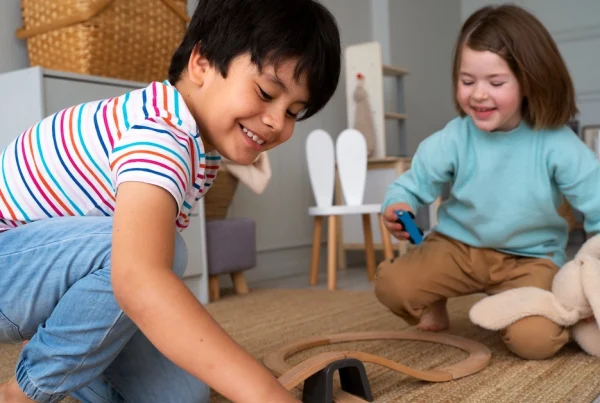Anna Dewdney, a picture book author, once said, “Empathy is an understanding that other people have feelings and that those feelings count.” However, with more time spent behind screens and less face-to-face interaction, empathy, a vital skill that helps us connect with others, is in decline. As students navigate an increasingly online world, there is a growing need to actively cultivate empathy to ensure that they recognize others’ emotions and respond with kindness and care.
In this article, we will explore the importance of bridging this empathy gap and offer four practical ways to build empathy in students of the digital era.
The Fading Empathy of the Digital Generation
The rise of technology has brought numerous benefits but has also contributed to a decline in empathetic behavior, especially among the digital generation. Constant exposure to screens, social media, and digital communication often reduces the quality of human interactions.
In online environments, the absence of body language, tone, and emotional cues creates a disconnect that can erode meaningful connections. As a result, the ability to develop empathy and show empathy fades, making it harder for students and individuals to understand others’ emotions. This loss of empathy affects students in particular, as they struggle to practice empathy in their everyday lives and relationships.
Why Bringing Back Empathy is Essential
 Empathy is the ability to understand and share the feelings of others. It plays a critical role in building strong relationships and navigating social situations with compassion. Developing empathy fosters understanding, reduces prejudice, and is a cornerstone of emotional well-being.
Empathy is the ability to understand and share the feelings of others. It plays a critical role in building strong relationships and navigating social situations with compassion. Developing empathy fosters understanding, reduces prejudice, and is a cornerstone of emotional well-being.
Teaching empathy to children in educational settings is essential for creating a positive classroom environment where students feel heard, respected, and valued. When students practice empathy, it improves teamwork, supports conflict resolution, and promotes a sense of belonging within the school community. Through playful learning activities that teach empathy, educators can help students better grasp the importance of compassion in their lives.
In an increasingly divided world, initiatives for building empathy must be prioritized, especially in schools. By teaching students to understand others and encouraging them to put themselves in someone else’s shoes, we can raise a generation of socially conscious, emotionally mature individuals who are prepared to contribute to society with kindness and understanding.
To foster a compassionate school community, educators can implement activities and discussions designed to help students develop empathy, ensuring they are equipped with the emotional tools they need to thrive academically and socially.
Read Also: Mindful Parenting Tips in the Digital Age
The Challenges of Instilling Empathy in the Digital Era
 In the digital age, teaching empathy to children presents new difficulties as children increasingly rely on technology for communication. Face-to-face interactions are becoming less common, which affects students’ ability to develop essential social and emotional skills. Below are three key challenges in fostering empathy among students and approaches to help them overcome these barriers.
In the digital age, teaching empathy to children presents new difficulties as children increasingly rely on technology for communication. Face-to-face interactions are becoming less common, which affects students’ ability to develop essential social and emotional skills. Below are three key challenges in fostering empathy among students and approaches to help them overcome these barriers.
1. Reduced Face-to-Face Interactions
With the rise of digital communication, students are missing out on opportunities to engage in person, where nonverbal cues like body language and tone are vital for understanding emotions.
This reduction in real-life social interactions makes it harder for students to grasp how others feel and develop empathy naturally. Encouraging group work, role-playing, and in-person discussions can help bridge this gap.
2. The Impact of Cyberbullying and Online Anonymity
Cyberbullying and the anonymity of online spaces allow students to distance themselves from the emotional consequences of their words, making it harder to show empathy. Without seeing the immediate reactions of those they hurt, students may struggle to understand the effects of their actions.
Educators can counter this by teaching digital citizenship and encouraging students to be empathetic, even if they don’t agree with someone’s views, to promote online kindness.
3. Overcoming the Normalization of Harsh Online Behavior
The normalization of harsh, critical behavior online desensitizes students to the impact of negative interactions, reducing their emotional awareness. If left unchecked, this can also influence offline behavior, diminishing empathy in everyday life. To address this, educators can incorporate case studies and discussions about the emotional effects of words and actions, both online and offline, to help students develop empathy and become more compassionate.
8 Tips for Overcoming These Challenges
 While these challenges are significant, they are not impossible to overcome. Educators and parents can help students build this critical skill despite the complexities of the digital age by intentionally fostering empathy in daily interactions and through specific practices. Below are some practical strategies for teaching empathy and encouraging empathy in students.
While these challenges are significant, they are not impossible to overcome. Educators and parents can help students build this critical skill despite the complexities of the digital age by intentionally fostering empathy in daily interactions and through specific practices. Below are some practical strategies for teaching empathy and encouraging empathy in students.
1. Model Empathy in Real Life
The best way to teach empathy is to demonstrate it in everyday interactions. Teachers and parents play a crucial role in showing empathy in real-world situations. Adults can model empathy in action by responding with patience, understanding, and kindness during challenging moments—whether in the classroom or at home.
When students see adults taking the time to listen, consider others’ feelings, and offer thoughtful support, they are more likely to mimic this behavior in their interactions. Whether in the classroom or at home, modeling empathy helps students become more aware of the feelings of others and develop cognitive empathy. Empathy is an essential skill for emotional development and creating meaningful relationships.
2. Encourage Real-World Social Interactions
In the digital era, many students interact behind screens, making it challenging to develop essential social skills. Creating opportunities for real-world, face-to-face interactions is key to fostering empathy. Whether through group activities, collaborative projects, or social gatherings, students benefit from direct human contact, where they can observe and respond to emotional cues, such as facial expressions and body language.
These real-life interactions allow students to ask their peers questions, encourage them to think about what others might be feeling, and respond empathetically. By creating these opportunities, schools help students look beyond digital communication and build more profound, more meaningful relationships.
3. Incorporate Mindfulness Practices
Mindfulness can be an effective tool in helping students develop empathy by enhancing their emotional awareness. Through meditation, reflective discussions, or even simple breathing exercises, students learn to recognize their emotions and become more attuned to how their actions affect others.
Encouraging your students to practice mindfulness helps them regulate their emotions and better understand the feelings of their peers. As students practice empathy in the classroom, they are more likely to connect affective empathy (the emotional response to others) with cognitive empathy (understanding others’ perspectives), leading to a more compassionate school environment. This approach builds students’ capacity for empathy and enhances the emotional atmosphere of the entire school community.
4. Monitor and Guide Digital Behaviors
Since students these days mostly communicate online, monitoring and guiding their digital interactions is essential. Without proper guidance, students may engage in harmful behaviors like cyberbullying, which stifles empathy development.
Teaching students to demonstrate empathy in their online communications—by thinking before they post and being aware of how their words impact others—can help bridge the empathy gap in digital spaces. Schools and parents can create digital citizenship programs that encourage students to think before acting online and promote a culture of kindness in both online and real-world interactions.
Read Also: Tips on How to Prevent Tech Addiction in Children
5. Promote Perspective-Taking
Encouraging students to take on different perspectives is a powerful way to cultivate empathy. Teachers can incorporate perspective-taking exercises into their lessons, asking students to think about what others might think or feel in a given situation. This can be done through storytelling, role-playing, or analyzing historical events and characters.
When students engage in these exercises, they practice cognitive empathy by stepping outside their own experiences and considering others’ viewpoints. This skill helps students become more empathetic and equips them to navigate diverse social situations with greater understanding.
6. Engage in Community Service Programs or Activities
Community service offers students hands-on experiences that foster empathy through real-world engagement. By helping those in need, students gain insight into the struggles of others and develop a stronger sense of compassion and responsibility. Schools that emphasize service learning, like Sekolah Pelita Harapan (SPH), encourage students to become more socially aware and empathetic by participating in local and global outreach programs.
These activities teach students that their actions can positively impact others and help them connect emotionally with their communities. Community service is an effective way to teach children both cognitive and affective empathy.
7. Using Technology for Good
Technology doesn’t have to be a barrier to empathy; it can also be a tool to promote positive change. Schools can encourage students to use digital platforms for social causes, raising awareness about global issues and demonstrating empathy toward others worldwide.
At SPH, students participate in digital projects that promote social justice or contribute to charitable causes, using technology to build bridges of understanding. This approach encourages students to help students reflect on global challenges, giving students the chance to practice empathy across different cultures and communities, proving that technology can be a force for good when used with purpose.
8. Practice Emotional Literacy
Developing emotional literacy is fundamental to building empathy in students. Students must first understand their own emotions before they can recognize and respond to the emotions of others. Emotional literacy involves the ability to identify, express, and manage emotions effectively.
SPH’s Social Emotional Learning (SEL) curriculum teaches students to articulate their feelings, helping them become more self-aware. Classroom activities like journaling, reflective discussions, or guided meditation can enhance emotional literacy by giving students a safe space to explore their feelings. As students become more emotionally aware, they can better understand how others feel and respond compassionately, thus deepening their empathy and ensuring they are equipped to interact effectively with students from different backgrounds.
Read Also: How to Develop Media Literacy in Children
Bridging the Empathy Gap Through Social-Emotional Learning (SEL)
Social-emotional learning (SEL) provides an excellent framework for fostering empathy in students. SEL programs are designed to help students develop self-awareness, self-control, and interpersonal skills that are vital for school, work, and life success. Sekolah Pelita Harapan (SPH) implements SEL in its curriculum, helping students build empathy, compassion, and active listening skills.
At SPH, SEL is integrated into everyday learning through group activities, discussions on emotions, and role-playing scenarios that allow students to step into another person’s shoes. Our school emphasizes a holistic education approach, equipping students with academic knowledge and the emotional and social tools needed to thrive in today’s world.
Building empathy in the digital era is challenging, but it is essential to creating compassionate, socially aware students. Through the combination of the SEL curriculum, real-world experiences, and guidance in responsible digital behaviors, Sekolah Pelita Harapan is taking vital steps to bridge the empathy gap. By fostering cognitive and affective empathy, SPH helps students understand and connect with others on a deeper level, equipping them to handle complex emotional and social situations.
The result? A generation of intellectually capable, emotionally intelligent students and ready to make the world a better place through empathy and leadership. As an international school in Indonesia, Sekolah Pelita Harapan provides a holistic education that shapes students to thrive academically, socially, and emotionally in a global context.
Discover more about Sekolah Pelita Harapan and how our SEL approach nurtures students to become well-rounded, empathetic individuals. Contact us today to learn how SPH can support your child’s growth!








